Lodz operation
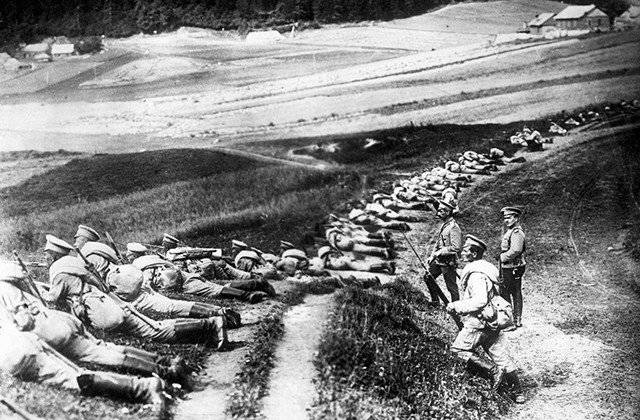
100 years ago, 11 November 1914, the Lodz operation began. The German command overtook the advance of the Russian troops and struck in order to encircle and destroy the 2 and 5 of the Russian armies. The Lodz operation became one of the largest and most complex operations of the maneuverable period of the war - the operation of deep detours and environments. About 750 thousand people participated in this battle. The German strike was hurriedly organized, the operation was risky and led to the risk of the death of a part of the 9 of the German army. The German troops themselves got into the bag, from which they could get out only because of the mistakes of the Russian command. The Russian army won this major battle, but the German command was able to foil the idea of a deep invasion of Germany.
According to some researchers, this operation could change the course of the entire war. The numerous, large-scale Russian personnel army, capable of fighting with the German army on an equal footing and fleeing it, was aimed at Berlin. The Russian "steamroller" could change the course of the whole war. However, due to the mistakes of the Russian command, the chance was missed to inflict a decisive defeat on the German army and force Berlin to seek a political solution. As a result, the war became protracted, destructive for both Germany and the Russian Empire.
The situation before the battle
Two great battles, Galician (Galician battle; Part of 2; Part 3; Part 4) and the Warsaw-Ivangorod operation ended with the victory of the Russian army (Warsaw-Ivangorod operation; Part 2). The Austro-Hungarian troops retreated a second time to the Carpathian frontier. German troops moved to the Kalisz - Czestochowa line. 9-I German army sought to cover Silesia. At the same time, the 8-I German army, under pressure from the 1-th and 10-th Russian armies, was forced to retreat into the depths of East Prussia under the protection of the Masuria Lakes. As a result, the situation on the Eastern Front was extremely difficult for the German and Austro-Hungarian empires. The Russian cadre army, despite the mistakes of command, problems in organizing the logistics and supply, won a number of serious victories in major battles and oppressed the enemy.
When withdrawing, German troops tried to avoid new battles with the Russians. And the Austrians were faced with the task of preventing a Russian invasion of their territory through the Carpathian Mountains, which could lead to a military-political catastrophe. "Patchwork Empire" was on the verge of collapse.
To get out of the difficult situation on the Eastern Front, the German command decided to launch an offensive in Prussia. This offensive was to prevent the deep invasion of Russian troops in Germany and lead to a radical change on the Eastern Front.
German plans and strengths
The German command, having learned from the intercepted radiograms about the plan of the Russian invasion into the borders of Germany (it was planned to launch the offensive on November 14), decided to forestall the Russian offensive. Hindenburg and Ludendorff drew up a plan that boiled down to a deep blow to the flank and rear of the 2 and 5 Russian armies preparing for an offensive in the Poznan direction.
It must be said that in the organization of intelligence and radio communications, the situation in the Russian army was simply catastrophic. The tragedy of the 2 Army of Samsonov did not teach the Russian command anything. Russian military radio was disgusting. The Germans deciphered the Russian dispatches faster than the Russians themselves. The chief of the German Field General Staff, General Erich von Falkenhain, later wrote that Russian radiograms gave the German command "an opportunity from the beginning of the war in the East to half of the 1915 of the year to follow the enemy's movement from week to week and even often from day to day and take appropriate countermeasures" .
The German army 9, commanded by General August Mackensen, from Czestochowa and Kalisz was transferred by train to Thorn. From there, she was supposed to strike a sudden blow to the 2 and 5 to the Russian armies. Mackensen's army, which suffered great losses in previous battles, was replenished and strengthened. It included two cavalry corps (1 and 3) and redeployed 8 and 1 from the 25 army. In addition, from the garrison parts of the fortresses of Poznan, Breslavl and Thorn formed three consolidated corps.
Having learned about the plans of the Germans, the Austro-Hungarian command began an accelerated transfer from the south of the 2 of the Austro-Hungarian army to the Kreuzburg region in order to strengthen the right flank of the German army, which was preparing a strike on Lodz and Petrakov. In addition, the German group of General Voirsh was left southwest of Creutzburg. The 2 th Austro-Hungarian army and the corps of Voirsch were to battle down Russian troops on the right flank. From East Prussia, a strong corps of Tsastrov was supposed to act against the Russian troops against the Russian troops. He was reinforced by Holene's cavalry corps, which brought the German forces in the Mlav direction to 58 thousand bayonets and sabers with 120 guns and 100 machine guns.
Thus, the German command for flank attack concentrated a powerful strike fist - in the area of Yarochin, Thorn concentrated 5 1 / 2 army and 2 cavalry corps. Total 155 thousand bayonets and sabers with 950 guns and 450 machine guns. At this time, the corps "Breslavl" and "Poznan" were to forge the 5 Russian army from the front. Both corps numbered 45 thousand bayonets and sabers with 265 guns and 100 machine guns. On the left flank of the corps of Tsastrov and Holehen, the 1 Russian army was shackled. 8-I German army, hiding behind the Masurian lakes, held back the 10-th Russian army. On the right flank, Russian troops shackled the 2-I Austrian army and the Voirsha group. In addition, other Austro-Hungarian armies were supposed to support the German offensive with vigorous actions on their front sectors.
10 November 1914 German troops were to complete concentration, and November 11 - go on the offensive. However, by this time only the 9 Army was ready. The remaining compounds only concentrated or were still at the stage of formation. For example, Hollen's cavalry corps (2-I and 4-I divisions) could arrive only on November 15. The "Poznan" and "Breslavl" corps were to complete the formation and turn around by November 16. The 2-I Austro-Hungarian army ended its concentration in the Kreuzburg region no earlier than November 18. However, Hindenburg, knowing that Russian troops would go on the offensive on November 14, gave the order to launch the offensive on November 13 in order to launch a preemptive strike. In fact, the German command in some respects went on an adventure, as during the Warsaw-Ivangorod operation, hoping to preempt the enemy and cause confusion in the Russian troops. An important role was played by the interception of Russian radiograms. The Germans knew about the movement of Russian troops.
Before the onset of the 9 th German army, its forces were positioned as follows: Frommel's 3 Cavalry Corps stood east of Kalisch; 11-th corps in the area Yarochina; 17 Corps in the area of Wreshen; 20 Corps in the area Gogenzaltsa; 1 th cavalcourse southwest of Petrkov; 1-th Reserve Corps southwest of Thorn; The 25-th reserve corps in the area of Thorn, to the same direction also had to transfer the reserve (3-th Guards Reserve Division). All corps were replenished, each received two battalions of heavy artillery (32 guns), reinforced by air detachments and radio stations. At the first stage of the offensive, Mackensen’s army was to defeat and surround the 2 Russian army, and then other units of the Russian front.
In total, about 280 thousand bayonets and sabers, 1450 guns and 700 machine guns participated in the Lodz operation from Germany. Together with the 2 of the Austrian army and the Voirsch group, the number of Austro-German troops reached 380 thousand. Thus, on the direction of the main attack, the German command managed to create a significant superiority in manpower and artillery.
Plans and forces of Russia
The Russian command, unaware of the leakage of information and the impending offensive of the enemy, was preparing an invasion of Germany. Moreover, the main prerequisite of this operation was not the strategic interests of Russia, but the pressure of the Western allies, who demanded to strike at Germany and divert as many German forces as possible. On the Western Front, in the area of Ypres, there were stubborn battles. The Allies on the Entente literally begged the Russians to come to their aid, not to interrupt the movement of the Russian armies, and ideally to invade Germany. The Allies reported that the front barely held, and in the case of the transfer to the west of the German corps, retreating from the area of Warsaw, they could not avoid defeat. The Russian high command hurried to satisfy the interests of the allies.
The decision to conduct an offensive operation was made by the Russian command at the very moment when the German troops retreated to the front of Czestochowa, Kalisz and, breaking away from the pursuit, hiding behind the rear guards, border and other auxiliary units, they transferred to the Thorn area. The Russian Stavka and the headquarters of the North-Western Front had incomplete and contradictory information about the enemy: it was believed that about 4 German corps had moved to the Czestochowa region, about 2 corps to Velun, to the Klobucko fortified line, near Kalisz - about 2 corps. From the side of Thorn noticed only two divisions.
On the basis of these data, where the main enemy forces were still to be located in the Czestochowa-Kalisz area, the commander of the North-Western Front, Nikolai Ruzsky, ordered to launch an offensive, break the enemy's resistance, and go to the Jarocin-Kempen-Katowice line. The offensive was to be led by the forces of the 2 and 5 armies of the North-Western Front and the 4 and 9 armies of the South-Western Front. The left flank covered the Caucasian corps, the right flank covered the 2 of the army corps. In addition, the right flank of the armies advancing on Germany should have covered the 1 Army. To do this, the 6 th Siberian Corps received the task to start the crossing to the left bank of the Vistula, where the 5 th Siberian corps was already located. Thus, the Russian armies were preparing for a frontal attack, not knowing about the concentration of a powerful enemy attack force on the right flank and about the threat of a flank strike, which threatened to defeat the 2 Army. The entire Russian plan of operation was reduced to a simple movement forward, without bypass maneuvers, dissecting and covering strikes, without a second echelon for the development of the offensive.
Having received new data from intelligence, the headquarters informed Ruzsky that it could be located up to the enemy's 4 corps between the Vistula and the Warta. The front commander, Ruzsky, replied that he would take the new data into account, but in fact left them unattended and for a long time did not believe in the existence of an enemy group in the Thorn area. The Russian armies were pulled out on a large front, had no army and front reserves for developing success or for parrying possible enemy counterattacks. This led to the initial success of the German offensive and the serious difficulties of the Russian troops in repelling the enemy strike. In addition, between the 2 and 1-I Russian army there was a serious gap, which was covered only by minor cavalry forces. The 5 Siberian and 2 corps, located on the adjacent flanks of the two armies, stood on a broad front, did not have any communication with each other and were cut off from the main forces of their armies. At the same time, the Russian personnel army still had a high fighting spirit, many divisions that had already participated in battles with the Germans and Austro-Hungarians, showed a higher combat capability than the enemy.
As a result, the Germans were able to deliver a flank attack, and the Russian armies were forced to conduct heavy defensive battles in the first stage. The nature of the operation has changed, and three Russian army units took part in it: 1) The 1 Army under the command of Pavel Rennenkampf in the 4 corps, 3 1 / 2 cavalry divisions. In total, the army had more than 123 thousand bayonets and sabers, 440 guns and 200 machine guns; 2) Sergey Scheidemann’s 2 Army as part of 5 corps, 4 cavalry divisions. In total, the army had more than 158 thousand people, 540 guns and 350 guns; 3) 5-I army of Paul Plehve in the 3 corps and 1 1 / 2 cavalry divisions. The army had 85 thousand bayonets and sabers, 320 guns and 190 machine guns. Total 367 thousand people and 1300 guns.
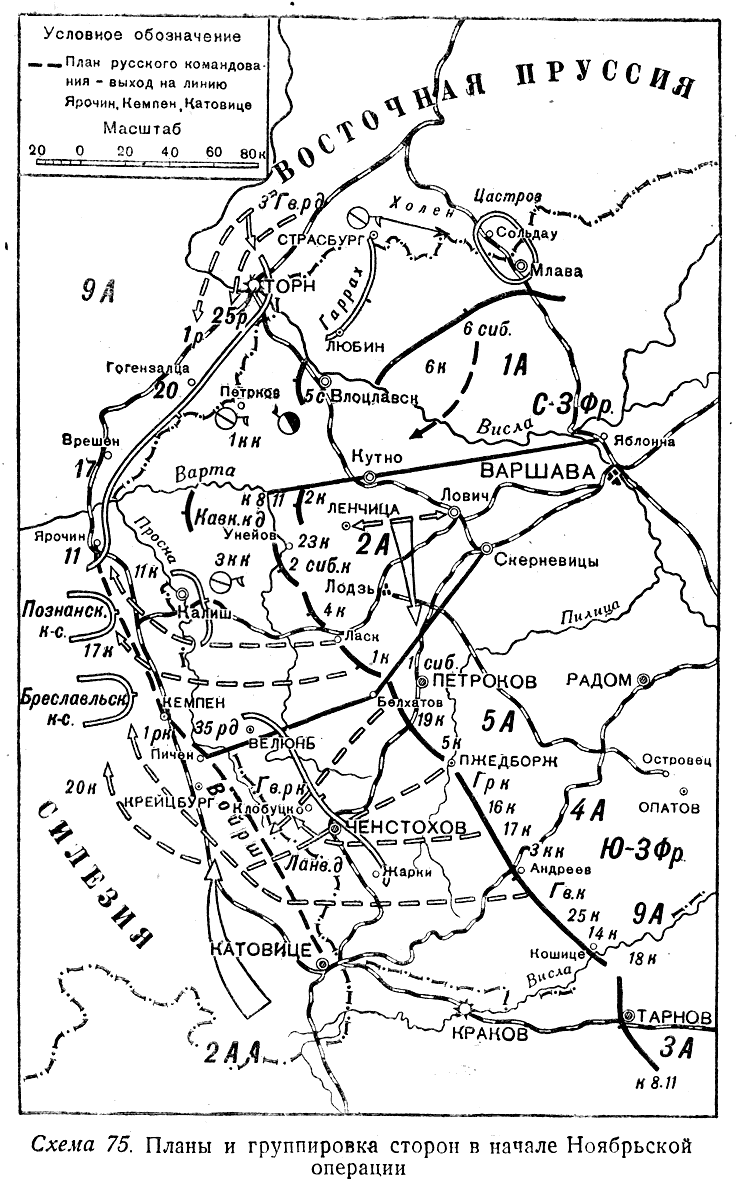
Source of maps: Kolenkovsky A. Maneuverable period of the first world imperialist war 1914.
German offensive
The commander of the 9 Army Mackensen prepared his plan for the offensive. Initially, he wanted to defeat the 5 Siberian Corps, then the 2 Corps, then surround the 2 Russian army. Mackensen wanted to destroy the two flank Russian corps, their simple pushing did not suit him, since in this case the plan for the entourage of the 2 of the Russian army was difficult to implement. Initially, Hindenburg launched an offensive against 13 in November, but so that the Russians did not solve the German plan for an offensive and did not have time to take retaliatory measures, Mackensen postponed the offensive on the morning of November November.
At this time, the 5 th Siberian Corps of General Sidorin (79-I and 50-I infantry divisions) occupied a stretch of defense at 30 km on the front Gombinek-Hozen. The right flank of the corps was covered by the Vistula, on the left flank was the Consolidated Cossack Division. The corps was in a weakened state, it did not have any divisions laid out by the state, there were also no corps artillery and cavalry, 6 battalions from the corps were sent to strengthen the garrison of the fortress Novogeorgiyevsk and other needs. The situation was aggravated by the fact that the distance from the 5 of the Siberian Corps to Thorn was less than to the nearest Russian corps.
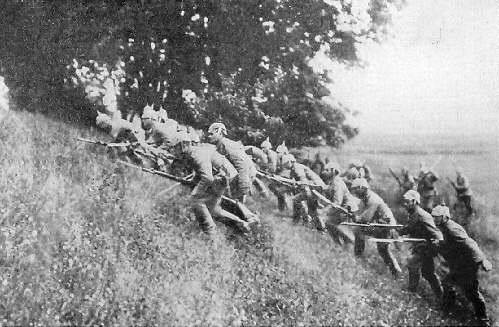
On the morning of November 11, the German troops marched and, after making the 40-km march, in some places came into contact with the guard posts of the Russian corps. By evening, the Germans took to the line of settlements of Ustron - Petrkov - Golina. The commander of the Russian corps, General Sidorin, had the opportunity at night to withdraw his troops to new positions, but, not representing the full degree of threat, he did not. Sidorin gave the order to hold their positions.
On the morning of November 12, the German three army (20-th army, 1-th and 25-th reserve corps) and one cavalry corps attacked Russian positions. The Germans had a complete advantage not only in the number of bayonets and sabers, but also were supported by heavy artillery and armored vehicles. German troops were drawn into the battle gradually, first the head units, then the main forces. As a result of a stubborn, unequal battle, the Russian right-flank 79-I infantry division began to bend its flank back, retreating to a second defensive position prepared in advance.
After lunch, the Germans threw the main forces of the three corps into battle. In a number of places under the brutal pressure of the enemy, the Russian units retreated to the second position, but nowhere did they allow themselves to circumvent or break through their battle formations. The German command, seeing the failure of the first attack, began a strong artillery preparation from the 15 watch. The commander of the 5 Siberian Corps received the news that the 6 Siberian Corps coming to his aid was delayed, under the cover of the Cossack division, moved to a new position at the villages of Dudinov - Patrovo - Rembov. The German troops, tired of the march and heavy fighting on November 12, were in no hurry to pursue the Russians. By the end of November 13, the 5 Siberian Corps took a new position. From the south, the 2 Army Corps moved to its aid.
Thus, from the very beginning, the Germans did not go according to plan. Mackensen failed to surround and destroy the 5 th Siberian corps, despite more than a triple superiority in forces. The German command in this battle did not act in the best way. German troops attacked a well-fortified stance on the forehead, did not attempt wide roundabout maneuvers, did not use a great superiority in forces, the troops were brought into battle in parts. In fact, the German army did not have a strike group in the direction of the main attack, all the corps attacked in uniform bands along the whole front. The Germans did not pursue the Russian troops, gave them the opportunity to calmly withdraw and gain a foothold in the new position.
Kutno battle
The commander of the 2 Corps, General Churin (26-I and 43-Infantry Divisions), having received the news of the appearance of large enemy forces in front of his and 5-Siberian corps, decided to close the path to Kutno. With the capture of Kutko in front of the German troops, a way was opened for entering the rear of the 2 of the Russian army. 2-th Army Corps took positions at the station Art. Budy - Zhakovets - Moves.
The German command, dissatisfied with the failure to destroy the 5 of the Siberian Corps, ordered that offensive action be intensified. On November 14, German troops were to encircle and destroy the Russian 2 corps. At first, the parts of the 20 corps went on the attack. German troops struck at the site railway Vlotslavsk - Kutno and Ivina village. Strong counterattacks offensive the enemy was stopped. Then the left flank of the 2 Corps attacked the 17 German Corps. Germans attacked in the direction of Krosniewice and tried to circumvent the Russian positions from the south. After a stubborn battle, Russian troops turned down the left flank in the village of Vyhny. Komkor Churin sent his reserve to a dangerous direction, and the Russian troops restrained the attacks of the enemy until evening. Only the Caucasian Cavalry Division covering the left flank was forced to retreat under the onslaught of the German infantry from the village of Sobotka to Shamov.
As a result, during the fierce battle, the 2 of the Russian corps as a whole retained its position, having withstood the blow of the superior forces of the enemy. German troops could not only surround the Russian corps, but even go around it deeply. Russian troops showed high combat capability. The Germans repeated the mistake of a battle with the 5 of the Siberian Corps - they introduced the units into battle in parts.
The front commander, Ruzsky, handed the 2 corps into submission to the 1 army and ordered 15 on November to launch a counterattack. Part of the 2 and 5 Siberian corps, as well as suitable connections of the 6 Siberian corps (while only two regiments approached) were to take part in the attack. The Komfronta did not yet believe in the big German offensive, believed that it was a private operation and the Germans could be broken by the forces of two corps.
It should be noted that General Nikolai Ruzsky was one of the most problematic figures in the Russian command. Even during the Battle of Galicia, he commanded the 3 army, he did not assist the neighboring 5 army Plehve, although he received instructions from the front command several times. Ruzsky sought to acquire the laurels of the liberator of Lviv. Then, after becoming commander of the North-Western Front during the Warsaw-Ivangorod operation, Ruzsky proved to be a weak strategist and extremely cautious, if not to say, a cowardly tactician. At the same time, he proved himself in intra-army intrigues, blaming his mistakes on subordinates and deftly pushing the generals between themselves.
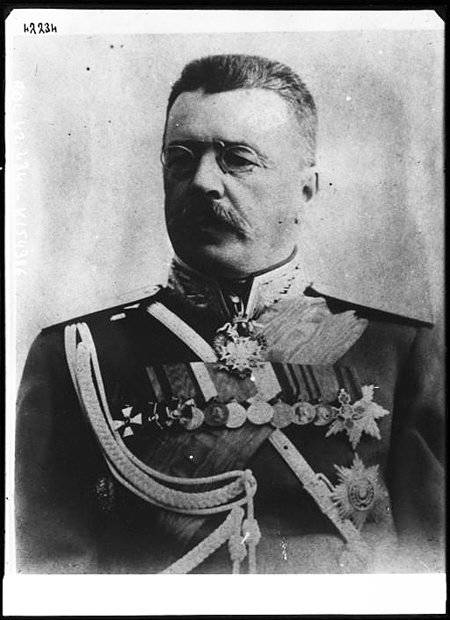
Commander-in-Chief of the armies of the North-Western Front Nikolay Ruzsky
It is clear that the two Russian corps, which in the morning of November 15 tried to go on the offensive, did not succeed. They could not overturn the reinforced 9 th German army. 5 th Siberian Corps in heavy battles was able to keep its front. However, in the evening there was a threat of bypassing the flanks by German troops, so the commander of the 1 Army Rennenkampf ordered the corps to withdraw to a new position. The troops moved to the line of settlements Poplatsin - Shchavin Bor. The tired German troops corps almost did not pursue, so the departure was organized. The 2 Corps also moved to a new position along the line of the villages of Golenske - Shevce-Dolne.
Thus, the battle of Kutno ended in favor of the Russian troops. The superior forces of the German army 9 unsuccessfully tried to surround and destroy two Russian corps, but could not do anything. Russian units retreated to new positions and retained their combat effectiveness. It should be noted that the German command had every opportunity to win, but made a lot of mistakes (the deployment of troops in parts, did not use all the possibilities to bypass the enemy, etc.). The first setbacks did not force Hindenburg to abandon the offensive; he ordered Mackensen to continue the offensive and surround the 2 of the Russian army. Ruzsky, even after these battles, refused to believe that the main forces of the 9 of the German army were advancing from Thorn.
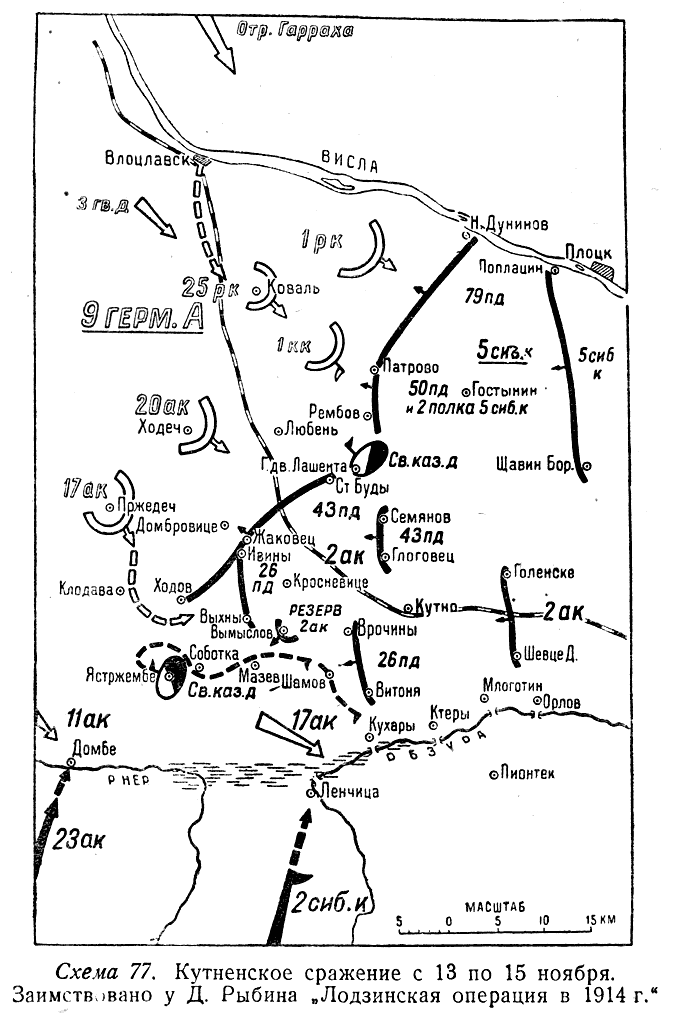
Redeployment of forces and adjustment of plans
Neither the front commander or the army commanders had any reserves, so to strengthen the defenses to the north, the commander of the 2 army, Scheidemann decided to move two more corps to the 2 corps — the 23 and 2 Siberian. November 14 The 23 Corps reached the Ner River, where it collided with the enemy (the 11 Corps). Russian troops could not take the crossing from Dombé. On the same day, the 2 th Siberian Corps advanced parts came out to the crossing over the Bzuru River at the Lenchitsy. Here, Russian troops clashed with parts of the 17 of the German corps. The whole day was a stubborn battle, but the Russian troops could not advance further north. At the same time, the corps of the left wing of the 2 Army (4 and 1) continued to move westward and, without meeting the resistance of the enemy, reached the Warta River. The 4 and 5 armies also moved to the west without meeting the enemy.
It was only in the evening of November 15 that Ruzsky began to realize that the German army was threatening the junction of the 1 and 2 armies and two Russian corps could not stop the enemy by blocking the 50-km front. Ruzsky ordered: 1) to the left flank of the 1 Army to go on the offensive, with the aim of holding down as large an enemy force as possible; 2) of the right-flank corps of the 2 Army (23 and 2 of the Siberian corps) to go on the offensive; 3) to the left flank of the 2 Army (4 and 1 buildings) to move away from Warta and concentrate in the area around Lutomorsk, Lask; 4) The 5-th army to stop the offensive and move back; 5) 4 st army stop. The main focus of the Russian command was on the area between the Vistula and the Warta, where the Germans were advancing. November 17 Ruzsky, worried about the situation at the front, ordered to launch a general offensive on the morning of November 18.
The German command, intercepting Russian directives, orders and reports (the Germans intercepted and read all the radiograms), decided that the situation was favorable for the continuation of the offensive. Most of the troops completed concentration, and the Russian command missed time to regroup the forces to the north, which would allow not only to stop the enemy, but also to defeat him at the initial stage of the battle. Hindenburg, assuming the inevitability of a general retreat of the Russian troops, suggested that the Austrians also proceed to a general offensive. Mackensen ordered: the Breslavl Corps to strike at the 5 of the Russian army; the Poznan Corps to attack the Wart; 3 of Frommel's cavalry corps in the general direction of Pabianice in order to bypass the left flank of the 2 army; The 17 Corps struck at Zgerj; 20 Corps for Breziny, 25 Corps and Reserve (3 Guards Division) for Strykow; 1 th cavalcourse on Laznovska Vola. The 1 th reserve corps covered the left, eastern flank of the 9 th army. Thus, after the approach of all the connections, Hindenburg decided to cover the entire 2 Russian army from the two flanks. The ring of the environment was planned to be washed off in the Lodz area.
To be continued ...
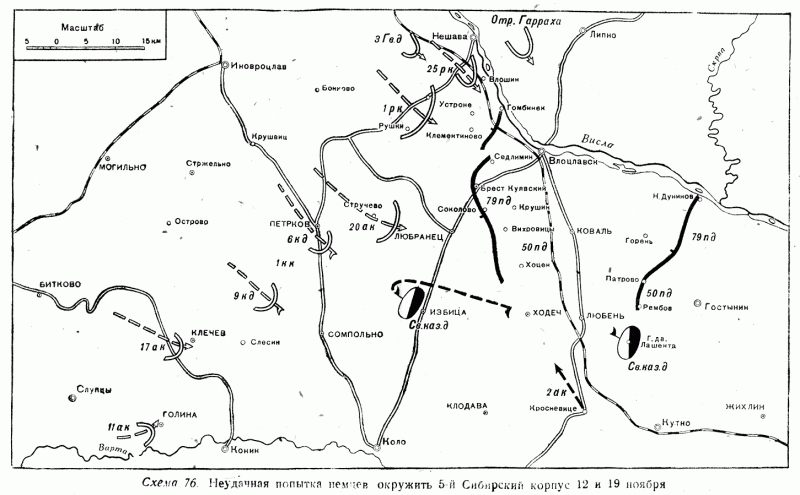
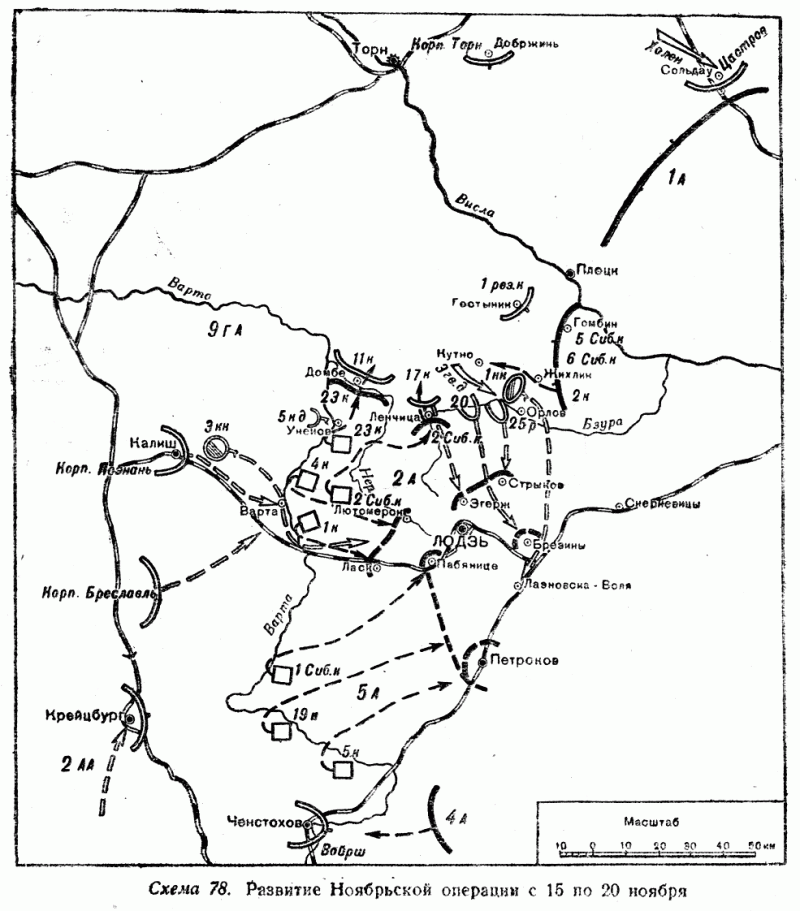
Information